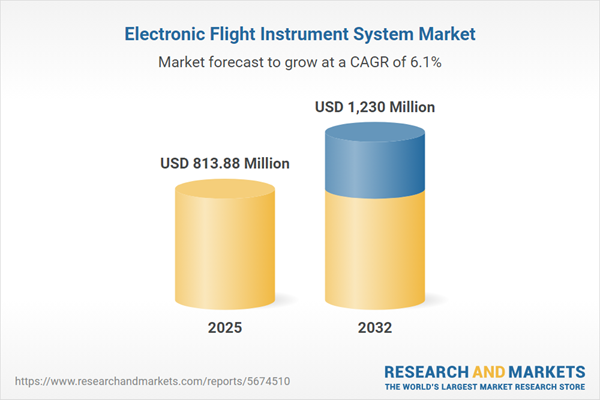Speak directly to the analyst to clarify any post sales queries you may have.
Electronic Flight Instrument System (EFIS) technologies are driving essential advancements in cockpit efficiency and digital integration, equipping aviation leaders to meet modernization goals and maintain operational continuity in a rapidly evolving industry.
Market Snapshot: Electronic Flight Instrument System Market Overview
The global Electronic Flight Instrument System market is valued at USD 765.95 million in 2024, with a compound annual growth rate of 6.12%. Market forecasts project growth to USD 813.88 million in 2025 and further expansion to USD 1.23 billion by 2032. This progression is largely attributed to airlines and operators accelerating the adoption of digital cockpit solutions, pursuing widespread modernization across both civil and defense fleets. Harmonization of regulatory requirements, together with rising fleet standards, reinforces the prominence of Electronic Flight Instrument System adoption in shaping aviation strategies worldwide.
Scope & Segmentation of the EFIS Market
- Aircraft Types: EFIS is deployed across business jets, commercial airliners, military aircraft, helicopters, fighters, troop transporters, and regional jets. Each aircraft segment demands tailored solutions that address unique mission profiles and distinct operational environments in both civil and defense applications.
- Display Technologies: Options include CRT, LCD, and LED technologies. Trends show modern fleets choosing LCD and LED for increased cockpit clarity, system dependability, and compatibility with advanced navigation needs in challenging conditions.
- EFIS Types: The market covers primary flight displays, multi-function displays, horizontal situation indicators, and alerting systems. This comprehensive suite improves situational awareness and supports compliance with demanding flight management requirements.
- End User Categories: Stakeholders such as manufacturers, OEMs, tier-one suppliers, passenger airlines, cargo carriers, and military operators play distinct roles in procurement and deployment, each influencing adoption rates and upgrade approaches across sectors.
- Integration Models: EFIS offerings include both integrated systems and standalone units, which enable phased upgrades, tailored modernization, and reduced operational disruption as operators transition to newer technology.
- Geographies: The sector encompasses the Americas, Europe, Middle East & Africa, and Asia-Pacific. Regional market dynamics are shaped by local regulations, priorities in digital transformation, and fleet modernization investment, with significant momentum from countries like the U.S., Germany, UAE, China, and India.
- Key Players: Leading companies include Honeywell International Inc., Collins Aerospace, Thales S.A., L3Harris Technologies, Garmin Ltd., Elbit Systems, Avidyne Corporation, Genesys Aerosystems, Universal Avionics, and Astronautics Corporation. These players drive innovations that define competitive direction and product evolution globally.
Key Takeaways for Senior Decision-Makers
- Deploying advanced Electronic Flight Instrument System solutions improves operational reliability, empowering crews with enhanced real-time situational awareness across fleets and mission types.
- Flexible system configurations help organizations adapt to shifting regulatory landscapes, supporting smooth upgrades, structured maintenance, and efficient long-term fleet planning.
- Upgraded LCD and LED EFIS displays offer improved visibility in complex cockpit conditions, resulting in long-term operational savings and increased safety margins for flight crews.
- Current EFIS platforms support streamlined data management, enabling robust communication and timely decision-making during routine and exceptional operations.
- Alignment of EFIS deployment with regional certification and compliance frameworks reduces rollout delays, minimizes implementation bottlenecks, and accelerates project delivery for operators and suppliers.
Tariff Impact: U.S. Aviation Tariffs of 2025
With new U.S. aviation tariffs taking effect in 2025, EFIS suppliers and operators are responding by diversifying suppliers, increasing component stock, and improving assembly processes. These actions help maintain steady access to vital avionics components, ensuring operational continuity and minimizing the impact of shifting trade conditions.
Methodology & Data Sources
This analysis draws on a comprehensive evaluation of technical documents, regulatory standards, and operational practices. Insights include expert interviews with avionics professionals, airline representatives, and procurement specialists to ensure actionable and relevant market intelligence for executive planning.
Why This Report Matters
- Helps senior leadership align fleet modernization initiatives with current Electronic Flight Instrument System innovations for commercial and defense applications.
- Delivers clear, actionable guidance to technical managers navigating regulatory, geographic, and operational complexities in global EFIS deployment.
- Supports risk mitigation with targeted regional intelligence on the factors driving digital infrastructure changes in the aviation sector.
Conclusion
Adopting Electronic Flight Instrument System solutions enhances safety, streamlines compliance, and promotes consistent operational outcomes. This report provides executive insight for strategic planning, enabling sustainable fleet modernization and positioning organizations for future requirements.
Additional Product Information:
- Purchase of this report includes 1 year online access with quarterly updates.
- This report can be updated on request. Please contact our Customer Experience team using the Ask a Question widget on our website.
Table of Contents
3. Executive Summary
4. Market Overview
7. Cumulative Impact of Artificial Intelligence 2025
Companies Mentioned
The companies profiled in this Electronic Flight Instrument System market report include:- Honeywell International Inc.
- Collins Aerospace, Inc.
- Thales S.A.
- L3Harris Technologies, Inc.
- Garmin Ltd.
- Elbit Systems Ltd.
- Avidyne Corporation
- Genesys Aerosystems, Inc.
- Universal Avionics Systems Corporation
- Astronautics Corporation of America
Table Information
| Report Attribute | Details |
|---|---|
| No. of Pages | 191 |
| Published | October 2025 |
| Forecast Period | 2025 - 2032 |
| Estimated Market Value ( USD | $ 813.88 Million |
| Forecasted Market Value ( USD | $ 1230 Million |
| Compound Annual Growth Rate | 6.1% |
| Regions Covered | Global |
| No. of Companies Mentioned | 11 |









